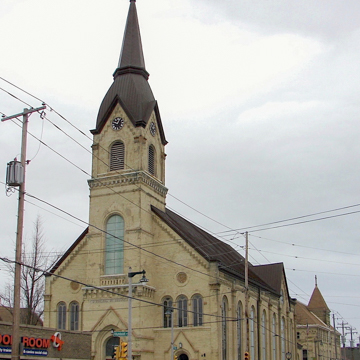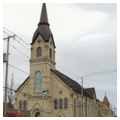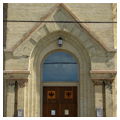St. Hedwig’s was Milwaukee’s second Polish parish, founded in 1871 by about forty families from Poland’s Baltic Sea coast. The church has a prominent square tower in the center of the facade, and its copper-clad helmet dome supporting the slender polygonal spire resembles the dome-topped towers common in Poland at the time of St. Hedwig’s construction. The church’s spire became its Polish neighborhood’s chief landmark. Inside, the coved plaster ceiling is typical of many Polish American churches of the late nineteenth century. Although the vault is original, the nave’s decoration has been dramatically simplified. Until the late 1950s, the walls, particularly in the apse and at the front of the nave, were painted with angels, floral and tree-branch patterns, and other motifs. After 1965, the Milwaukee Roman Catholic Diocese adhered to the Second Vatican Ecumenical Council’s admonition to “commemorate saints who are truly of universal importance” and limit excessive artistic decoration. The diocese interpreted these liturgical reforms by encouraging St. Hedwig’s to paint over the elaborate wall decorations and leave only statues of Joseph and Mary in tall, shallow niches at the front of the nave.
You are here
St. Hedwig Roman Catholic Church
If SAH Archipedia has been useful to you, please consider supporting it.
SAH Archipedia tells the story of the United States through its buildings, landscapes, and cities. This freely available resource empowers the public with authoritative knowledge that deepens their understanding and appreciation of the built environment. But the Society of Architectural Historians, which created SAH Archipedia with University of Virginia Press, needs your support to maintain the high-caliber research, writing, photography, cartography, editing, design, and programming that make SAH Archipedia a trusted online resource available to all who value the history of place, heritage tourism, and learning.





